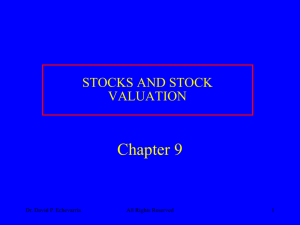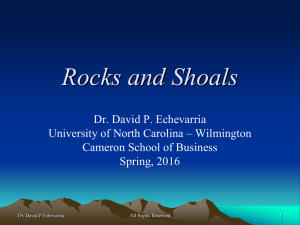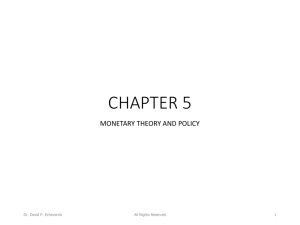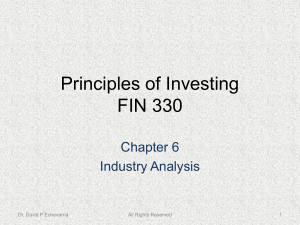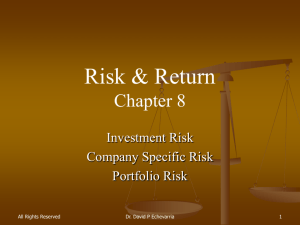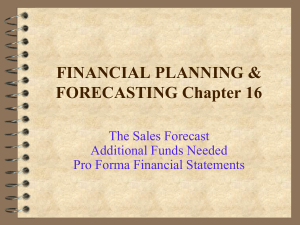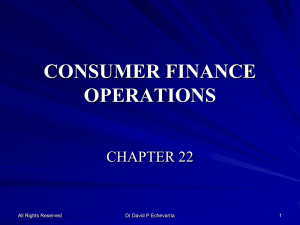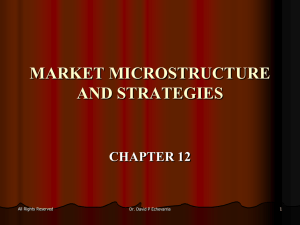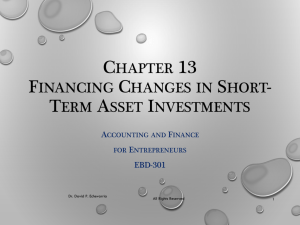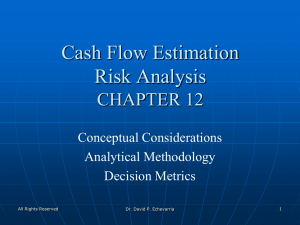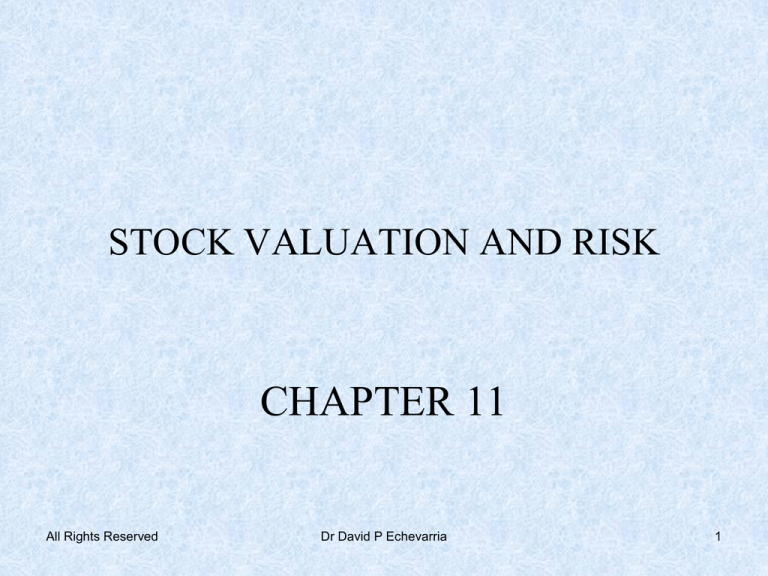
STOCK VALUATION AND RISK
CHAPTER 11
All Rights Reserved
Dr David P Echevarria
1
Benjamin Graham
The essence of Graham's value investing is that
any investment should be worth substantially
more than an investor has to pay for it. He
believed in thorough analysis, which we would
call fundamental analysis. He sought out
companies with strong Balance sheets, or those
with little debt, above-average profit margins,
and ample cash flow. (Securities Analysis, 1934,
written with David Dodd)
Investopedia
2
Benjamin Graham
He coined the phrase "margin of safety" to explain his commonsense formula that seeks out undervalued companies whose stock
prices are temporarily down, but whose fundamentals, for the
long run, are sound. The margin of safety on any investment is
the difference between its purchase price and its intrinsic value.
The larger this difference is (purchase price below intrinsic), the
more attractive the investment - both from a safety and return
perspective. The investment community commonly refers to
these circumstances as low multiple stocks;
Price/Earnings, Price/Book, Price/Sales
All Rights Reserved
Dr David P Echevarria
3
John Burr Williams
One of the first economists to view stock prices
as determined by “intrinsic value”, is recognized
as a founder and developer of fundamental
analysis. He is best known for his 1938 text "The
Theory of Investment Value", based on his Ph.D.
thesis, which was amongst the first to articulate
the theory of Discounted Cash Flow (DCF)
based valuation, and in particular, dividend
based valuation.
Wikipedia
4
Nassim N. Taleb
“The Black Swan”
The black swan theory or theory of black swan events is a metaphor that describes
an event that comes as a surprise, has a major effect, and is often inappropriately
rationalized after the fact with the benefit of hindsight.
1. The disproportionate role of high-profile, hard-to-predict, and rare events that
are beyond the realm of normal expectations in history, science, finance, and
technology
2. The non-computability of the probability of the consequential rare events using
scientific methods (owing to the very nature of small probabilities)
3. The psychological biases that make people individually and collectively blind to
uncertainty and unaware of the massive role of the rare event in historical affairs
Wikipedia
5
STOCK VALUATION MODELS
A. Importance of Efficient Stock Valuation
Models
1. Identify over- or under-valued stocks
2. Assist in investment efficiency
All Rights Reserved
Dr David P Echevarria
6
Value: Three Models
Basic: Value = Future Cash Flows / k
k = discount rate
A. Modigliani & Miller: V = NOI / k*
B. Sharpe, et alia: Price = FCF / ke
Where: ke = Rf + b (Rm – Rf)
C. Gordon: Price = Div1 / (k – g)
Subject to: k > g ≥ 0
All Rights Reserved
Dr David P Echevarria
7
STOCK VALUATION MODELS
C. Price-Earnings Multiplier (P/E ratio)
1. Measure of investment attractiveness
2. Earnings-Price Yield
D. Factors Affecting Stock Price Movements
1.
2.
3.
4.
Anticipated future earnings
General economic conditions
Interest Rates
Inflationary expectations
All Rights Reserved
Dr David P Echevarria
8
MODERN PORTFOLIO THEORY
Harry Markowitz
A. Two sources of risk
1. Variance
2. Covariance
B. The Efficient Frontier
1. Locus of efficiently price securities or portfolios
2. Securities not on the EF are inefficiently priced
All Rights Reserved
Dr David P Echevarria
9
CAPITAL ASSET PRICING MODEL
William Sharpe, et alia
A. Pricing risky assets in market equilibrium
1. Are Investment A's cash flows correlated with the market
[portfolio] M?
2. The relative volatility (riskiness) of a security is captured
by its Beta (B)
3. The coefficient of correlation, r (rho); degree of comovement of A and M
B. Total risk is separated into two components
1. Diversifiable: individual firm riskiness
2. Non-Diversifiable risk: the tendency to move with the
market (relative risk)
All Rights Reserved
Dr David P Echevarria
10
STOCK MARKET EFFICIENCY
A. Forms of Efficiency
1. Weak Form (historical data)
2. Semi-Strong Form (current news)
3. Strong Form (insider information)
B. Empirical Test Results: Is the market a random
walk? Can you consistently beat the market?
1. Weak Form: unexplained volatility suggests market not
weak form efficient.
2. Semi-Strong Form: a number of anomalies have been
discerned
3. Strong Form: insiders can and do successfully beat the
market
All Rights Reserved
Dr David P Echevarria
11
GLOBALIZATION OF STOCK
MARKETS
A. International placement of stocks; multinational market for placement
B. Integration among international stock
markets; magnitude of co-movement varies
C. International diversification as method of
reducing portfolio risk
All Rights Reserved
Dr David P Echevarria
12
HOMEWORK QUESTIONS
A. What is the difference between the MPT and
CAPM in terms of risk measurement?
B. What are the principal determinants of stock
price movements?
C. What particular problems do under-valued
stocks encounter?
D. Why we would include foreign stocks in our
investment portfolio
All Rights Reserved
Dr David P Echevarria
13

